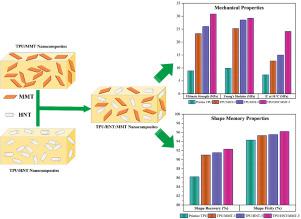当前位置:
X-MOL 学术
›
Appl. Clay. Sci.
›
论文详情
Our official English website, www.x-mol.net, welcomes your
feedback! (Note: you will need to create a separate account there.)
Microstructural design for enhanced mechanical and shape memory performance of polyurethane nanocomposites: Role of hybrid nanofillers of montmorillonite and halloysite nanotube
Applied Clay Science ( IF 5.3 ) Pub Date : 2020-11-01 , DOI: 10.1016/j.clay.2020.105816 Arian Amirkiai , Mahyar Panahi-Sarmad , Gity Mir Mohamad Sadeghi , Mohammad Arjmand , Mahbod Abrisham , Parham Dehghan , Hossein Nazockdast
Applied Clay Science ( IF 5.3 ) Pub Date : 2020-11-01 , DOI: 10.1016/j.clay.2020.105816 Arian Amirkiai , Mahyar Panahi-Sarmad , Gity Mir Mohamad Sadeghi , Mohammad Arjmand , Mahbod Abrisham , Parham Dehghan , Hossein Nazockdast

|
Abstract Herein, the effect of simultaneous incorporation of two silicate-based nanofillers, including montmorillonite (Mt) and halloysite nanotube (Hal), on mechanical and shape memory performance of thermoplastic polyurethane (TPU) nanocomposites was studied. Different amounts (1, 3, and 5 wt%) of Hal, Mt. and hybrid Hal:Mt. were embedded into TPU matrix, utilizing a melt mixing method. Morphological studies on the hybrid nanocomposites elucidated that appropriate dispersion and distribution were achieved. Higher transition temperatures, as well as lower degrees of crystallinity, were observed for TPU/Hal:Mt. nanocomposites, compared to the other counterparts. Dynamic-mechanical-analysis (DMA) results illustrated superior storage modulus in the hybrid nanocomposites in both glassy and rubbery regions owing to superlative polymer–filler interactions. According to the tensile measurements, the hybrid nanocomposites demonstrated remarkable improvements in Young's modulus as well as ultimate strength and elongation at break than those of solo-nanocomposites due to better stress transfer from the hybrid fillers to the TPU. Superior ameliorations of storage modulus, both in glassy and rubbery regions, consequently effectuated the shape memory performance of the hybrid nanocomposites. For instance, 5 wt% incorporation of the hybrid filler within the matrix enhanced shape fixity ratio, shape recovery ratio, and recovery speed by 6.1%, 2.9% and 2.3 s, respectively, compared to pristine TPU.
中文翻译:

用于增强聚氨酯纳米复合材料机械和形状记忆性能的微结构设计:蒙脱石和埃洛石纳米管混合纳米填料的作用
摘要 在此,研究了同时掺入两种基于硅酸盐的纳米填料,包括蒙脱石 (Mt) 和埃洛石纳米管 (Hal),对热塑性聚氨酯 (TPU) 纳米复合材料的机械和形状记忆性能的影响。不同量(1、3 和 5 重量%)的 Hal,Mt。和混合 Hal:Mt. 被嵌入到 TPU 基质中,使用熔融混合方法。对混合纳米复合材料的形态学研究表明,实现了适当的分散和分布。对于 TPU/Hal:Mt,观察到更高的转变温度以及更低的结晶度。纳米复合材料,与其他同类产品相比。动态力学分析 (DMA) 结果表明,由于最高级的聚合物-填料相互作用,混合纳米复合材料在玻璃状和橡胶状区域均具有优异的储能模量。根据拉伸测量,由于从混合填料到 TPU 的更好的应力转移,混合纳米复合材料比单独纳米复合材料在杨氏模量以及极限强度和断裂伸长率方面表现出显着改善。玻璃状和橡胶状区域的储能模量的显着改善,因此实现了混合纳米复合材料的形状记忆性能。例如,与原始 TPU 相比,在基体中掺入 5 wt% 的混合填料将形状固定率、形状恢复率和恢复速度分别提高了 6.1%、2.9% 和 2.3 秒。根据拉伸测量,由于从混合填料到 TPU 的更好的应力转移,混合纳米复合材料比单独纳米复合材料在杨氏模量以及极限强度和断裂伸长率方面表现出显着改善。玻璃状和橡胶状区域的储能模量的显着改善,因此实现了混合纳米复合材料的形状记忆性能。例如,与原始 TPU 相比,在基体中掺入 5 wt% 的混合填料将形状固定率、形状恢复率和恢复速度分别提高了 6.1%、2.9% 和 2.3 秒。根据拉伸测量,由于从混合填料到 TPU 的更好的应力转移,混合纳米复合材料比单独纳米复合材料在杨氏模量以及极限强度和断裂伸长率方面表现出显着改善。玻璃状和橡胶状区域的储能模量的显着改善,因此实现了混合纳米复合材料的形状记忆性能。例如,与原始 TPU 相比,在基体中掺入 5 wt% 的混合填料将形状固定率、形状恢复率和恢复速度分别提高了 6.1%、2.9% 和 2.3 秒。由于从混合填料到 TPU 的更好的应力转移,s 模量以及极限强度和断裂伸长率比单独纳米复合材料的要低。玻璃状和橡胶状区域的储能模量的显着改善,因此实现了混合纳米复合材料的形状记忆性能。例如,与原始 TPU 相比,在基体中掺入 5 wt% 的混合填料将形状固定率、形状恢复率和恢复速度分别提高了 6.1%、2.9% 和 2.3 秒。由于从混合填料到 TPU 的更好的应力转移,s 模量以及极限强度和断裂伸长率比单独纳米复合材料的要低。玻璃状和橡胶状区域的储能模量的显着改善,因此实现了混合纳米复合材料的形状记忆性能。例如,与原始 TPU 相比,在基体中掺入 5 wt% 的混合填料将形状固定率、形状恢复率和恢复速度分别提高了 6.1%、2.9% 和 2.3 秒。
更新日期:2020-11-01
中文翻译:

用于增强聚氨酯纳米复合材料机械和形状记忆性能的微结构设计:蒙脱石和埃洛石纳米管混合纳米填料的作用
摘要 在此,研究了同时掺入两种基于硅酸盐的纳米填料,包括蒙脱石 (Mt) 和埃洛石纳米管 (Hal),对热塑性聚氨酯 (TPU) 纳米复合材料的机械和形状记忆性能的影响。不同量(1、3 和 5 重量%)的 Hal,Mt。和混合 Hal:Mt. 被嵌入到 TPU 基质中,使用熔融混合方法。对混合纳米复合材料的形态学研究表明,实现了适当的分散和分布。对于 TPU/Hal:Mt,观察到更高的转变温度以及更低的结晶度。纳米复合材料,与其他同类产品相比。动态力学分析 (DMA) 结果表明,由于最高级的聚合物-填料相互作用,混合纳米复合材料在玻璃状和橡胶状区域均具有优异的储能模量。根据拉伸测量,由于从混合填料到 TPU 的更好的应力转移,混合纳米复合材料比单独纳米复合材料在杨氏模量以及极限强度和断裂伸长率方面表现出显着改善。玻璃状和橡胶状区域的储能模量的显着改善,因此实现了混合纳米复合材料的形状记忆性能。例如,与原始 TPU 相比,在基体中掺入 5 wt% 的混合填料将形状固定率、形状恢复率和恢复速度分别提高了 6.1%、2.9% 和 2.3 秒。根据拉伸测量,由于从混合填料到 TPU 的更好的应力转移,混合纳米复合材料比单独纳米复合材料在杨氏模量以及极限强度和断裂伸长率方面表现出显着改善。玻璃状和橡胶状区域的储能模量的显着改善,因此实现了混合纳米复合材料的形状记忆性能。例如,与原始 TPU 相比,在基体中掺入 5 wt% 的混合填料将形状固定率、形状恢复率和恢复速度分别提高了 6.1%、2.9% 和 2.3 秒。根据拉伸测量,由于从混合填料到 TPU 的更好的应力转移,混合纳米复合材料比单独纳米复合材料在杨氏模量以及极限强度和断裂伸长率方面表现出显着改善。玻璃状和橡胶状区域的储能模量的显着改善,因此实现了混合纳米复合材料的形状记忆性能。例如,与原始 TPU 相比,在基体中掺入 5 wt% 的混合填料将形状固定率、形状恢复率和恢复速度分别提高了 6.1%、2.9% 和 2.3 秒。由于从混合填料到 TPU 的更好的应力转移,s 模量以及极限强度和断裂伸长率比单独纳米复合材料的要低。玻璃状和橡胶状区域的储能模量的显着改善,因此实现了混合纳米复合材料的形状记忆性能。例如,与原始 TPU 相比,在基体中掺入 5 wt% 的混合填料将形状固定率、形状恢复率和恢复速度分别提高了 6.1%、2.9% 和 2.3 秒。由于从混合填料到 TPU 的更好的应力转移,s 模量以及极限强度和断裂伸长率比单独纳米复合材料的要低。玻璃状和橡胶状区域的储能模量的显着改善,因此实现了混合纳米复合材料的形状记忆性能。例如,与原始 TPU 相比,在基体中掺入 5 wt% 的混合填料将形状固定率、形状恢复率和恢复速度分别提高了 6.1%、2.9% 和 2.3 秒。











































 京公网安备 11010802027423号
京公网安备 11010802027423号